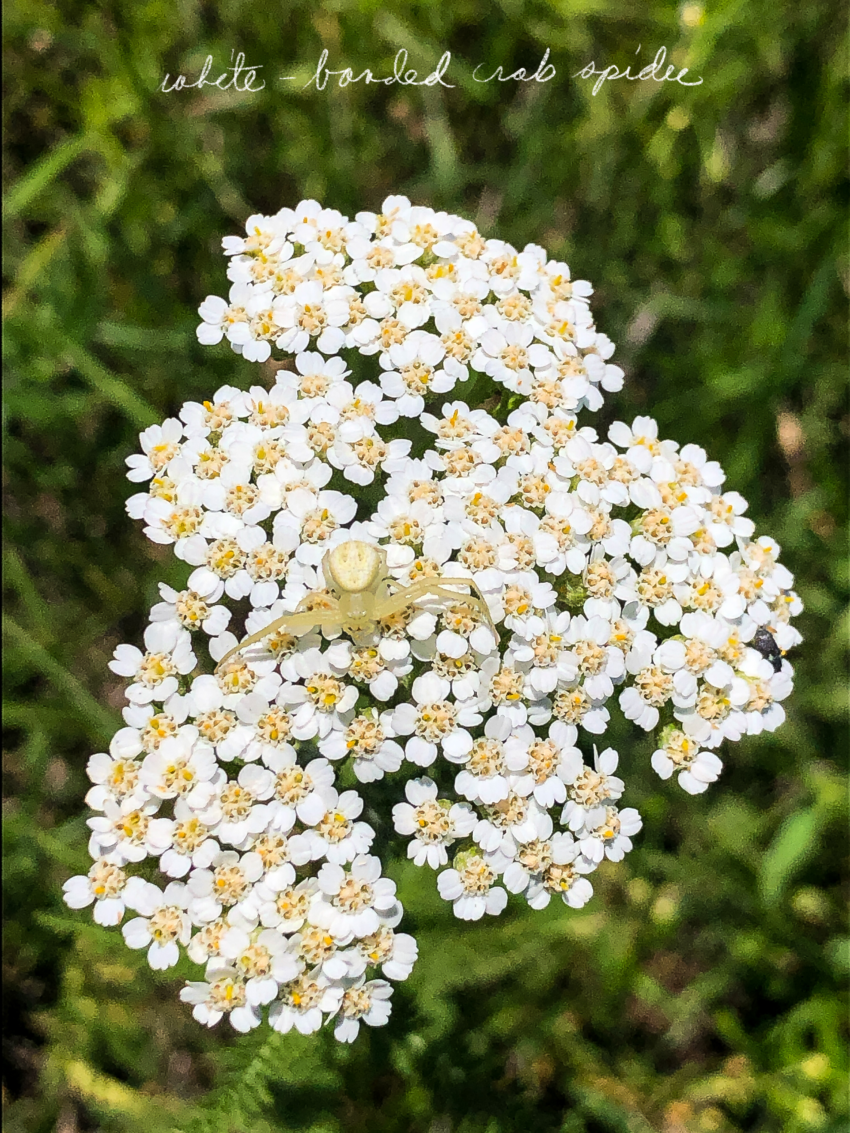by Bluestem
Depending on the source, studies of such things estimate that one is between 3 centimeters and ten feet away from a spider at any given time. Location matters.

The odds of brushing up against an eight-legged creature are low if you are hanging out in a parking lot. But if you are standing on your lawn or in a field, your feet are ringed on all sides by spiders of varying sizes. Some may be winging by on sparkling threads of silk, focused on relocating to the top of a nearby stalk of bluestem.

Another may be considering hitching a ride on your pant leg with plans to overwinter in your cozy home. One or two lie underneath your footwear, wondering who turned out the lights. No doubt all of them have one thing in mind: the next meal.

I lean towards the 3-centimeter estimate over 10 feet, but that’s because we are surrounded by grass. We share our home and fields with (among others) the dark fishing, brown recluse, black widow, green lynx, tarantula, wolf, grass, house, orb weaver, crab and the many and varied jumping spiders that we have affectionately nicknamed Bruisers because they will square off against any threat of any size, any time.

They are all neck and shoulders, often brightly-colored, and are really quite adorable.


On especially dewy and humid mornings the webs in the fields stand out in stark relief, shimmering with delicate shiny beads. There are thousands of webs, stacked among the grasses like tenement houses. Some stand tall and proud and bold as flags on poles. Others are built for stealth. From certain angles the webs look solid and their whiteness against the green is like a bay filled with sailing ships.

Most webs hang vertically in the traditional way, but others lay horizontally, tiny trampolines inviting the unwary to step in and jump around for a while. In the center of each web sits a spider. Some are pale as the morning, others a dusky orange. Still others are caustic yellow peppered with black. There are disorganized webs that resemble messy tufts of cotton candy. Other webs are meticulously spun as if created with a slide rule and a chalk reel. These are lovingly maintained and repaired daily by their house-proud spiders.

One summer my heart was stolen by a beautiful yellow and black garden orb that made her home just above our garage door. My husband and I watched her as if she were a long-running documentary series.

In the mornings she’d work steadily and slowly to repair her web after the carnage from the previous night, after the violent death throe struggles of some unfortunate winged victim which was then sucked dry and unceremoniously dropped to the pavement below. By lunch her web was tidy and clean. Nothing to see here. She sat at the center, looking sleepy and sated. But it was all an act. Ms. Orb was incredibly light and fast on her many feet. And ravenous.

Like supplicants we would daily bring her fresh horseflies. The first time we did this she skittered to the top of her web and scrunched herself into a ball. But she soon learned that our approach meant a juicy meal and she would run towards our fingers as we placed the sacrifice into the sticky strands. She grew incredibly fat.

One day several tiny suitors appeared and she lost all interest in flies or grasshoppers. But then the males were gone—it would have been rude to ask to where—and her appetite returned. Over time she produced an impressive five egg sacs, carefully securing each one to the side of the garage. She did such a tremendous job that the egg sacs stayed steady through the remainder of the summer, through the fall, the cold winds of winter, and then into another summer.

Even though we knew the day was coming, we were heartbroken the morning the garden orb was gone. The web was achingly empty. I checked throughout the day to see if she’d returned, but apparently it had been her time and she had gone off to die alone and unseen. Eventually the pristine web fell into disrepair and disappeared completely. Only the egg sacs remained.

Sometime in the spring the garden orb’s five eggs “hatched.” We missed the exodus. The sacs were dented and empty, looking like deflated beignets, but stayed firmly secured to the garage for a long time. Where did all of the babies go? Off into the wide world, doing their good if grisly work. It would have been nice if one of her offspring had taken up residence in her mother’s place. We could tell her stories about her strong and caring mama while tempting it with buzzing horseflies.


